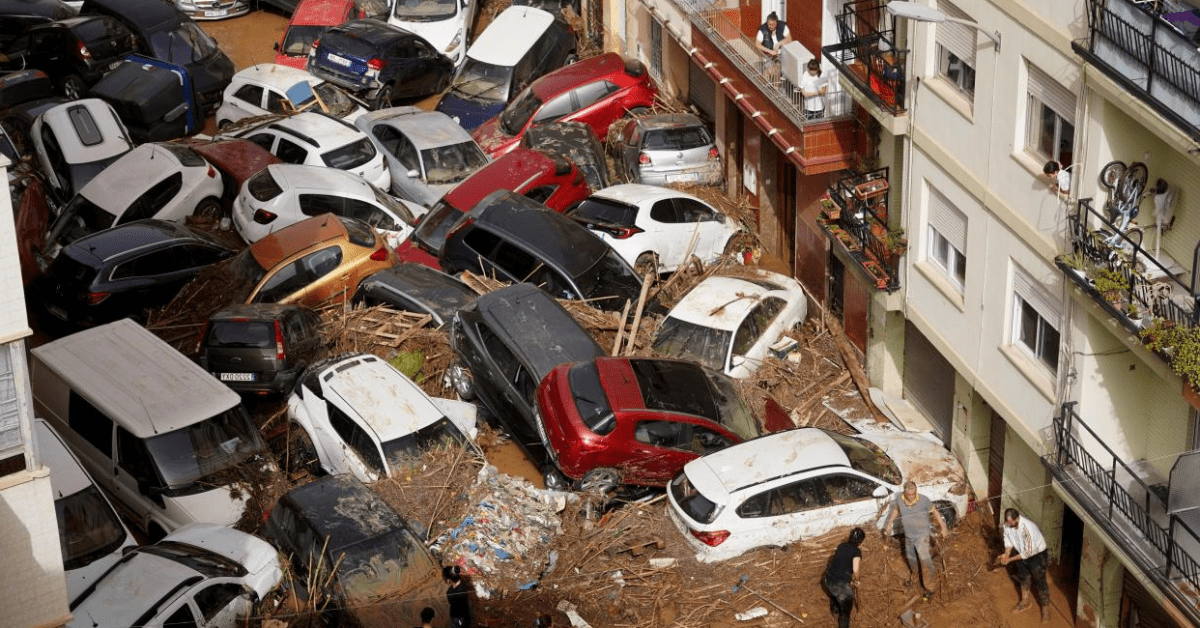Eastern Spain is reeling from the impact of catastrophic flash floods that have left at least 64 people dead, disrupted towns, and turned once-familiar streets into rivers of mud and debris. The tragedy has struck hardest in the Valencia region, where record-breaking rainfall flooded homes, swept away vehicles, and brought rail lines and roads to a standstill. Desperate rescue efforts continue as the nation grapples with one of its worst natural disasters in recent memory.
The floods began on Tuesday, following an intense storm that delivered nearly a month’s worth of rain to Valencia in just a few hours. The downpour was caused by a rare clash of warm Mediterranean waters and cold air currents, which meteorologists say fueled the devastating rain clouds. The impact was immediate and overwhelming. Entire neighborhoods in towns like Alzira and Utiel were submerged, and cars were swept through streets by fast-moving, mud-colored water. Homes and shops filled with debris, while streets became barely recognizable landscapes of piled-up branches, broken belongings, and layers of thick mud.
In a televised address, Prime Minister Pedro Sánchez expressed heartfelt condolences to the victims and pledged full government support. “For those looking for their loved ones, all of Spain feels your pain,” he said, assuring affected communities that every resource was being mobilized for rescue and recovery.
Among the victims was an elderly couple who were trapped in the upper story of their home, later rescued by soldiers using a bulldozer. In another tragic case, a man in the town of Massanassa lost his life after becoming trapped in an underground parking area while trying to check on his vehicle. Some residents, including those stranded in vehicles or on rooftops, had to wait hours for rescue crews to arrive. In an industrial estate in Riba Roja, workers and truck drivers took refuge atop vehicles when a nearby bridge collapsed, cutting off all escape routes.
Rescue operations have deployed more than 1,000 soldiers and emergency response units, backed by helicopters and heavy machinery. Helicopters airlifted stranded residents, while firefighters used rubber boats to reach drivers trapped on rooftops of cars in rising waters. Even as rescue operations continue, regional authorities caution that the death toll may climb higher, as some remote areas remain inaccessible.
The storm has caused extensive damage to transportation networks. High-speed rail services between Valencia and Madrid were halted, with trains and flights canceled due to unsafe conditions. Several schools and essential services remain closed, and regional President Carlos Mazón has urged residents to avoid travel, particularly in northern Valencia, where rain has shifted and continues to threaten local roads.
Local stories reveal the horrifying moments that many endured. A taxi driver named Paco recounted how he was caught in a sudden torrent while driving toward the CV-36 motorway. “It was impossible to get out of the car,” he said. “A man in a lorry helped me, but I didn’t think I’d get out alive. I saw a young girl clinging to a lamp post. The force of the water was brutal.” Similar harrowing stories have emerged from across the region, where people narrowly escaped death by seeking higher ground.
The response has been swift, with both regional and central government offices establishing emergency protocols to speed up rescue and identification processes. A crisis committee has been set up to coordinate efforts, and special phone lines have been activated to assist those searching for missing loved ones.
Spain’s King Felipe VI expressed his deep sorrow, stating, “The royal family is devastated by the latest news,” and praised the resilience and bravery of emergency workers. Valencia’s regional president emphasized the historic nature of this tragedy, describing it as a “materially impossible” event, unlike anything seen in recent years.
In the wake of the floods, many towns face the daunting task of recovery. Streets and buildings are caked in layers of mud over 30 centimeters deep in some places, with residents walking out to assess what can be salvaged. In Barrio de la Torre, a village near Valencia, a bar owner described the area as “completely smashed up,” with everything “ready to be thrown away.”
The storm has reignited concerns over Spain’s vulnerability to extreme weather. The country, which recently battled severe droughts, has also seen record-high temperatures in recent years. Scientists warn that climate change may be intensifying such events, leading to more frequent and powerful storms.
While the immediate focus remains on search-and-rescue efforts, the recovery journey for these affected towns is likely to be long and challenging. For now, residents and officials alike are united in hope and determination, working together to rebuild their communities from the wreckage.
